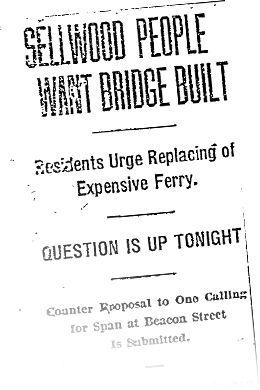


However, the Sellwood Club remained active in promoting the idea of a bridge to replace the ferry, and petitioned the county commissioners to place the issue on the ballot.
In July 1922 there were plans for a $1 million dollar span at Sellwood, but by September economics led to a shift to save money by re-using spans from the 1894 Burnside Bridge, which was to be replaced by a new bascule bridge (The Oregonian, October 1, 1922). Sellwood Bridge proponents noted that a crossing at Sellwood – at a narrow section of the Willamette River - could be significantly cheaper than competing bridge options at other locations, (The Oregonian, September 15, 1922) and the ability to reuse the spans from the old Burnside bridge would be a cost effective way to create two river crossings. It was also argued that the new Sellwood Bridge would actually save money in the long run, with annual maintenance costs being $7,000 per year cheaper than the current "antiquated and inadequate" ferry service (The Oregonian, October 24, 1923).
Voters passed several bonds between 1922 and 1924 to pay for three spans across the Willamette: a rebuilt Burnside Bridge and two new "high spans" to be located at Sellwood and Ross Island. The $5 million bridge program was reputed to be “the most extensive bridge programme of any city in America” (The Oregonian, January 1, 1924).
The original designs for the new bridges came from the firm Hedrick & Kremers. The Sellwood Bridge was to make use of the recycled through-truss spans from the Burnside Bridge, while the Ross Island Bridge would be a “high and massive [causeway] of reinforced concrete.” The new Burnside span was also to be made of concrete (The Oregonian, January 1, 1924).
Although many members of the public preferred the concrete designs, the Ross Island and Burnside bridges would later be changed to steel due to concrete’s higher cost.
Previous: Before the Bridge | Next: The Great Bridge Scandal